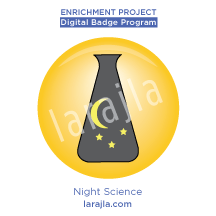 From science to the senses, there are many ways to can use the night to help expand our understanding of the world.
From science to the senses, there are many ways to can use the night to help expand our understanding of the world.
Steps
Playing with our senses
1. Night vision.
Discuss how our vision works and how darkness affects it. Demonstrate how rhodopsin breaks down in light by having the group sit in the dark and close their eyes. Light a candle and ask them to open on eye only and stare at it for 2 minutes. Then blow out the candle and explore what the group can see with each eye. Find other activities to help explore how our eyes react to darkness.
2. Bioluminescence / night sparks.
Discuss bioluminescence (light without electricity). Examples include fireflies and foxfire. To do a quick experiment, give each person a Wint O Green® lifesaver. In the dark, let them take turns chewing with their mouth open. Be sure you know why this occurs so you can share it with your group.
3. Sounds of the night.
Listening to the sounds of the night and identifying sounds helps those who are scared of the dark. If you can identify it, it doesn’t scare you. This can be done by quietly sitting and pointing out sounds, providing cards/sheets for sounds to listen for, or make it a game where everyone shines flashlights where they think the sound is coming from and discuss what they heard. If you have problems hearing the sounds of the night, cup your ears to help.
4. Smell that scent.
Create a series of scent jars. The darkness helps the mind concentrate on scent. Let them guess what each scent is. Do it a second time after wetting the underside of their noses. What is the difference? You may do this in the darkness or with blindfolds.
Exploring the night
5. Stargazing.
Identifying stars and constellations can be fun. Be sure to have some stories about how the constellations were formed. Explore the Web to find ways to help share constellations from puzzles to crafts to stories.
6. Get closer.
While identifying stars and constellations is a great group activity, using a telescope to get a better view is limited to a smaller group or individuals. Try using a telescope to get closer to the night sky.
7. Moon phases.
Using the phases of the moon, discuss the way the moon looks, the length of time it takes to cycle through the phases (29.5 days), waxing and waning, and more. The phases include:
- Crescent
- Half
- Gibbons
- Full
- New
You might also want to talk about specific moon views such as a harvest moon or blood moon and why they occur.
8. Nocturnal animals and reptiles.
Learn about nocturnal animals, especially ones you are likely to encounter locally. This might include bats, rattlesnakes or frogs. You can find color sheets, information sheets and more online. Pick one and learn about its habitat, why it is nocturnal and ways you can help support it.
9. Nocturnal birds.
Some birds, such as owls, are also nocturnal. Learn more about our feathered friends who enjoy the night. Like Step 8, learn more about the bird, why it is nocturnal and ways you can help support it.
10. Nocturnal insects.
Fireflies (lightning bugs) are just one kind of the many insects you can find at night. They are the most fun as you can catch them as they blink by. A discussion of mosquitoes and ways to avoid / treat bites is a good insect activity. Sugaring for moths might be another possibility. Other ideas are finding out what bugs are attracted to light. Try one or more of these or make your own insect experiments in the dark.
Even more science
11. Light pollution.
When you’re driving home at night, look at cities and towns to see the glow of the lights that extend beyond the area. This is light pollution. Learn about light and how light affects wildlife. Explore the lights in your area. Do they help or hurt wildlife.
12. PBS.
www.pbs.org/seeinginthedark/for-teachers
Explore a wide variety of night science activities for kids and choose one or more to try yourself.
13. Take a trip.
Visit a local planetarium or observatory . . . or check one out online. What scientific activities can you share with your troop or group?
14. Crafting science.
Make something to help you understand the science of the night. This might include:
- Constellation charts
- Star clock
- Galileo telescope
- Astrolabe
15. Rocket.
Try your hand at building a rocket. It doesn’t have to be complicated. Try an alkazeltzer or bottle rocket. You can go crazy and try out model rocketry. Look at different rocket possibilities and try one.
16. Keep experimenting.
Continue searching and experimenting to find even more dark science. Keep track of your research and what works for you.
Sites to Explore
- www.gosoftworks.com/GoSkyWatch/GoSkyWatch.html
- www.skymaps.com
- www.darksky.org
- www.windows2universe.org/citizen_science/starcount
- analyzer.depaul.edu/paperplate/lights.htm
- www.northern-stars.com
- oceanservice.noaa.gov/education/projects/makeyourownastrolabe.pdf
- www.lawrencehallofscience.org/starclock/starclockprintout.html
- www.space.com/24114-how-to-build-a-telescope-science-fair-projects.html
- space.about.com/od/fungamesandhumor/tp/shortactivities.htm
- www.wikihow.com/Build-a-Bottle-Rocket
- www.physics.org/interact/physics-to-go/alka-seltzer-rocket
Leave a Reply